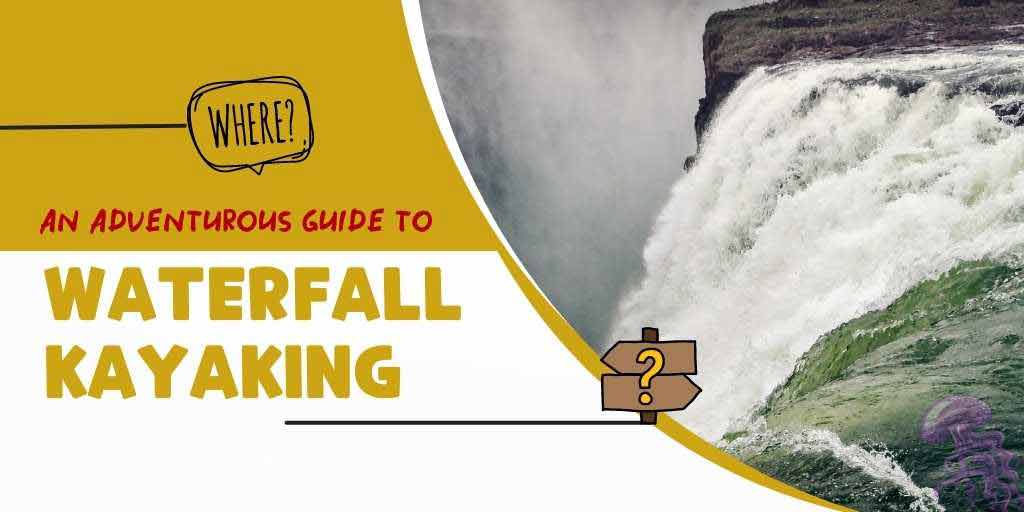If you love the thrill of whitewater kayaking, then you’ll definitely want to give it a try to kayaking in waterfalls. There’s nothing quite like hurtling down a raging river, dodging rocks and other obstacles, and getting soaked from the spray of the water.
This extreme sport is not for the faint of heart, but it’s definitely an adrenaline rush like no other.
Jump To A Section
Why Do People Kayak Over Waterfalls?
The simple answer is: because it’s awesome!
Paddling over a waterfall is an exhilarating experience that is unlike anything else. It’s the ultimate rush of adrenaline.
Of course, there’s also the challenge factor. Waterfall kayaking is one of the most challenging extreme sports out there. It takes a lot of skill and experience to paddle successfully over a waterfall.
So, if you’re looking for a true adventure, kayaking over waterfalls is definitely for you!
Here’s why it’s so exciting;
One of the main reasons why waterfall kayaking is so exciting is because of the sheer drop-offs. When you’re paddling over a waterfall, you’re often looking at a drop of 30 feet or more. This can be an extremely exhilarating experience, especially if you’re not used to heights.
Another reason why waterfall kayaking is so exciting is because of the speed. When you’re paddling over a waterfall, you can reach speeds of up to 40 miles per hour. This is definitely not for the faint of heart, but it can be an amazing rush.
In this article, we’ll take a look at what you need to know before kayaking over a waterfall, including the risks involved, how to minimize them, and some of the best places to do it. We’ll also give you some tips on how to make the most of your experience.
So, if you’re ready to take your kayaking to the next level, read on for our adventurous guide to kayaking over waterfalls.
The Risks Associated With Kayaking Over Waterfalls
There are two main risks to consider when kayaking over a waterfall: getting thrown from your kayak and hitting your head on a rock or other object.
Getting thrown from your kayak is the most common risk, and it can happen even if you’re using a life jacket. This is because the force of the water can easily flip a kayak, especially if it’s not properly secured.
To minimize this risk, it’s important to make sure that your kayak is properly secured before you attempt to paddle over a waterfall. You should also wear a life jacket, even if you’re an experienced kayaker.
Hitting your head on a rock or other object is another serious risk, and it can even be fatal. This is why it’s so important to wear a helmet when kayaking over waterfalls.
Even if you’re wearing a helmet, there’s still a risk of hitting your head on a rock or other object. To minimize this risk, it’s important to stay in the center of the kayak and to keep your head up as you paddle over the waterfall.

Guide To Waterfall Kayaking
If you’ve never been kayaking before, you might be wondering what to expect when you go over a waterfall. The most important thing to remember is to stay calm and focused.
The water will be flowing quickly, and the noise of the waterfall can be overwhelming, but it’s important to keep your cool. Once you’re at the top of the waterfall, you’ll need to paddle quickly to make it over the edge.
Once you’re over the waterfall, the excitement isn’t over yet. The current will be strong, and you’ll need to use all your strength to paddle to safety.
Let’s start the guide with basics;
Basics of waterfall Kayaking
Waterfalls are one of the most beautiful and awe-inspiring features of the natural world. They are also one of the most dangerous. Every year, people die or are seriously injured while attempting to kayak over a waterfall.
If you’re thinking about kayaking over a waterfall, there are some things you need to know first.
Here are the basics of waterfall kayaking;
Reading the Waterfall
One of the most important skills in waterfall kayaking is reading the water. This means being able to identify the different features of a rapid and understanding how they will affect your kayak.
Some things to look for when reading the water are the size and shape of the waves, the direction of the current, and any obstacles in the way. By understanding the water, you can better plan your route through the rapid.
Approaching the waterfall
The first thing you need to do when you’re approaching a waterfall is to assess the situation. Take a look at the size of the waterfall and the height of the drop. Is the waterfall too big for you to safely kayak over?
You also need to look at the water conditions. Is the water flowing too fast? Are there a lot of debris in the water? Is the waterfall located in an area with strong currents?
If you’re unsure about whether or not you can safely kayak over the waterfall, it’s best to err on the side of caution and portage around it.
At the top of the waterfall
Once you’ve reached the top of the waterfall, it’s time to make your final assessment. Take a look at the drop and the landing zone. Is the drop too steep? Is the landing zone too shallow?
If you’re still unsure about whether or not it’s safe to kayak over the waterfall, portage around it.
Entering the water
If you’ve decided that the waterfall is safe to kayak over, it’s time to enter the water. The best way to do this is to position your kayak so that it’s pointing straight over the edge of the waterfall.
Once you’re in position, lean back and let the kayak slide into the water. As you’re falling, tuck your knees into your chest and keep your head up.
Keeping your head up in the air
While kayaking waterfalls, keep your head up, so you can see where you are landing and adjust your course. The higher the waterfall, the higher your vertical entry angle should be. The less vertical your entry, the softer your landing will be.
Keeping your head up while kayaking waterfalls will ensure you don’t flip over. And, it will ensure you have plenty of air to breathe!
Hitting the water
When you hit the water, it’s important to stay calm and stay in your kayak. Immediately start paddling to the side so that you don’t go over the next waterfall.
If you find yourself in a situation where you’re being pulled over the next waterfall, try to relax and let the kayak go with the flow. In most cases, you’ll be able to ride out the current and eventually make it to safety.
Waterfall kayaking can be an exhilarating experience, but it’s important to remember that it’s also very dangerous. Make sure you assess the situation carefully before attempting to kayak over a waterfall. And if you’re ever in doubt, portage around it.
Use Your Edges
Using your edges is one of the most important techniques in waterfall kayaking. Your edges are the sides of your kayak that are closest to the water.
By utilizing your edges, you can control the direction of your kayak and avoid obstacles. For example, if you’re approaching a rock, you can use your edges to steer around it.
Stay Focused
Waterfall kayaking can be extremely stressful, so it’s important to stay focused at all times. If you lose focus, you may make a mistake that could lead to serious injury.
To stay focused, it’s helpful to have a plan for each rapid. Before you paddle, take a few minutes to think about your line and what you need to do to stay safe.
Practice, Practice, Practice
The best way to improve your skills in waterfall kayaking is to practice as much as possible. If you can, find a local river with some rapids to practice on!
Learn To navigate rapids For Getting The Most
Waterfall kayaking is an exciting and challenging way to enjoy the sport of kayaking. It can be a great way to test your skills and adrenaline levels and to see some amazing scenery. However, it is also important to be aware of the dangers involved in waterfall kayaking and to take the necessary precautions to stay safe.
Here are some advanced strategies for waterfall kayaking to help you navigate rapids safely:
Understand the different types of waterfalls
There are three main types of waterfalls – plunge, cascade, and hinged. Plunge waterfalls are the most common and occur when the river drops vertically over a ledge. Cascade waterfalls occur when the river drops over a series of ledges, and hinged waterfalls occur when the river flows over a rock that is wedged in the riverbed.
Scout the waterfall before paddling
It is essential to scout any waterfall before paddling it. This means getting out of your kayak and walking around to get a good look at the waterfall and the surrounding area. Look for any potential hazards, such as rocks or other obstacles in the water, and make a note of the best line to take when paddling over the waterfall.
Choose the right kayak for the job
Not all kayaks are suitable for paddling over waterfalls. It is important to choose a kayak that is designed for whitewater, such as a river-running kayak. These kayaks are designed to be stable in moving water and have a variety of features that make them ideal for paddling over rapids and waterfalls.
It’s ideal to choose an 8-foot round-hulled modern “creek boat.” This will reduce the impact of landing on a waterfall.
Use the right paddle strokes
Paddle strokes are different when kayaking over waterfalls than they are when paddling in flat water. It is important to use strokes that are specifically designed for moving water, such as the draw stroke and the sweep stroke. These strokes will help to keep you stable in moving water and will make it easier to paddle over rapids and waterfalls.
Be aware of the dangers
Waterfall kayaking can be dangerous, and it is important to be aware of the risks involved. There is a potential for serious injury or even death if you capsize or fall out of your kayak. It is important to paddle within your abilities and to be aware of your surroundings at all times.
By following these advanced strategies for waterfall kayaking, you can safely navigate rapids and enjoy the excitement and challenge of this thrilling sport.
Wear the right safety gear
It is essential to wear the right safety gear when waterfall kayaking. This includes a helmet, life jacket, and wet suit. A helmet will protect your head in the event of a fall, and a life jacket will keep you afloat if you capsize. A wet suit will help to keep you warm in cold water and will also provide some protection if you do fall out of your kayak.
The best places to go waterfall kayaking
Waterfall kayaking is one of the most exhilarating and challenging types of kayaking out there. But where are some of the best waterfalls to go kayaking? Here are just a few of the best places to go waterfall kayaking based on our own experience and research;
White River in Arkansas
The first place on our list is the White River in Arkansas. The White River is one of the most popular kayaking destinations in the country, and for a good reason. The river features Class III and IV rapids, making it perfect for those who are looking for a challenge.
Cheat River in West Virginia
If you’re looking for a place to go waterfall kayaking that’s a little less challenging, the Cheat River in West Virginia is a great option. The Cheat River is perfect for beginners and intermediate kayakers alike. The river features several Class II and III rapids, making it a great option for those who are looking to get their feet wet (literally) in the world of waterfall kayaking.
Nantahala River in North Carolina
Finally, one of the most popular places to go waterfall kayaking is the Nantahala River in North Carolina. The Nantahala River is one of the most popular kayaking destinations in the country, and for a good reason. In addition, the scenery along the river is absolutely breathtaking.
How can you stay safe while waterfall kayaking?
As we mentioned, waterfall kayaking is an extreme sport that comes with a high level of risk. So, it’s important to take all the necessary precautions to stay safe.
Here are some tips to help you stay safe while kayaking over waterfalls:
Choose your waterfall carefully
Not all waterfalls are created equal, and some are far more dangerous than others. Do your research before you paddle to a waterfall, and make sure you know what you’re getting yourself into. A waterfall with higher flows will have more aeration at the base and a gradual lip. This will allow a smooth transition from horizontal to vertical. If the drop-off is too sharp, it will cause over-rotation.
In addition to choosing a waterfall, one must decide the best entry angle. The higher the waterfall, the more vertical the entry angle needs to be. Another factor is the amount of aeration of the water. The more aeration there is, the less vertical the entry will need to be. This is important since it will affect the cushioning of the landing.
Line up your kayak
When you approach a waterfall, line your kayak up with the center of the flow. This will help you paddle through the waterfall without getting pushed off to the side.
Stay in the middle
Once you’re through the bulk of the waterfall, paddlers will often veer off to the side to avoid the powerful currents. However, it’s important to stay in the middle of the river to avoid rocks and other obstacles.
Don’t stop paddling
It can be tempting to stop paddling once you’re through the waterfall, but it’s important to keep paddling. Stopping can cause you to capsize or be pushed back into the waterfall.
Have an exit strategy
Before paddling over a waterfall, make sure you have a plan for getting out of the river if you get pulled into the waterfall. There should be an easy way to exit the river before you reach the waterfall.
What to do if you get stuck when kayaking over a waterfall?
If you’re an experienced kayaker, you know that kayaking over a waterfall can be an exhilarating experience. But what do you do if you get stuck in the middle of the waterfall?
Here are some tips on what to do if you find yourself stuck when kayaking over a waterfall:
This may seem difficult, but it’s important to stay calm so you can assess the situation and figure out a plan.
If you can’t see a way out, try to feel for one. Sometimes there may be a hidden ledge or a way to climb out.
If you can’t find a way out, use your paddle to help you move. You can use it to push off rocks or other objects to help you move.
This is dangerous and should only be attempted if you are absolutely sure you can make it.
If you can’t get out on your own, call for help. Make sure you have a phone with you so you can call for help. In the meantime, try to stay as safe as possible. If you’re stuck in the middle of the waterfall, hold onto your paddle, so you don’t lose it, and stay as close to your kayak as you can. If you’re stuck near the edge of the waterfall, be careful not to go over the edge.
Following these guidelines will help you stay safe while kayaking over waterfalls. It is an incredibly exhilarating experience that will leave you feeling both accomplished and invigorated. But remember, even if you take all the necessary precautions, there is still a risk involved. So, make sure you are comfortable with the risks before attempting a waterfall kayak.


